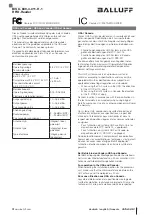
Chapter 3 Hardware Overview
DAQCard E Series User Manual
3-4
National Instruments Corporation
The software-programmable gain on these cards increases their
overall flexibility by matching the input signal ranges to those that
the ADC can accommodate. The DAQCard-AI-16E-4 has gains of
0.5, 1, 2, 5, 10, 20, 50, and 100 and is suited for a wide variety of
signal levels. With the proper gain setting, you can use the ADC’s
full resolution to measure the input signal. Table 3-2 shows the
overall input range and precision according to the range
configuration and gain used.
♦
DAQCard-AI-16XE-50
This DAQCard has two input polarities—unipolar and bipolar.
Unipolar input means that the input voltage range is between 0 and
V
ref,
where V
ref
is a positive reference voltage. Bipolar input means
that the input voltage range is between -V
ref
and +V
ref
. The
Table 3-2.
Actual Range and Measurement Precision
Range
Configuration
Gain
Actual Input Range
Resolution
1
0 to +10 V
1.0
2.0
5.0
10.0
20.0
50.0
100.0
0 to +10 V
0 to +5 V
0 to +2 V
0 to +1 V
0 to +500 mV
0 to +200 mV
0 to +100 mV
2.44 mV
1.22 mV
488.28
µ
V
244.14
µ
V
122.07
µ
V
48.83
µ
V
24.41
µ
V
-5 to +5 V
0.5
1.0
2.0
5.0
10.0
20.0
50.0
100.0
-10 to +10 V
-5 to +5 V
-2.5 to +2.5 V
-1 to +1 V
-500 to +500 mV
-250 to +250 mV
-100 to +100 mV
-50 to +50 mV
4.88 mV
2.44 mV
1.22 mV
488.28
µ
V
244.14
µ
V
122.07
µ
V
48.83
µ
V
24.41
µ
V
1
The value of 1 LSB of the 12-bit ADC; that is, the voltage
increment corresponding to a change of one count in the ADC
12-bit count.
Note:
See Appendix A
, Specifications,
for absolute maximum
ratings
.
















































